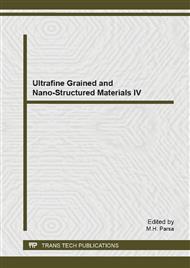p.737
p.742
p.747
p.752
p.757
p.762
p.767
p.772
p.778
Template Assisted Growth of Zinc Oxide-Based Nanowires and Piezoelectric Properties
Abstract:
In this paper, we report on the synthesis of ZnO nanowires via templated electrochemical deposition. ZnO nanowire arrays were fabricated by potentiostatic electrodeposition in track-etched polycarbonate (PC) membrane. The electrolyte was aqueous solution containing zinc nitrate precursor. The electrodeposition process involves the electroreduction of nitrate ions to alter the local pH and precipitation of the metal oxide within the pores. The morphology analysis and structure characterization of the ZnO nanowires were carried out using conventional scanning electron microscopy (SEM) and X-Ray diffraction. To check the piezoelectric characteristics of the zinc oxide nanowires, the AFM microscope is used in contact mode. The scanned area was 5µm*5µm and the affected force was 30nN. In result of scanning each nanowire with conductive AFM tip in contact mode, a current peak which had a width smaller than topography peak was fabricated. This is due to semi-conductivity and piezoelectricity characteristics of Nanowires.
Info:
Periodical:
Pages:
757-761
Citation:
Online since:
November 2013
Keywords:
Price:
Сopyright:
© 2014 Trans Tech Publications Ltd. All Rights Reserved
Share:
Citation:


